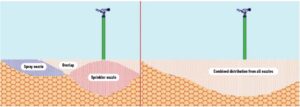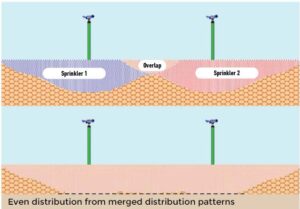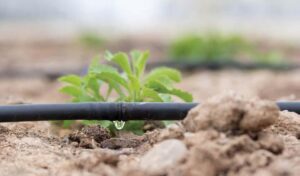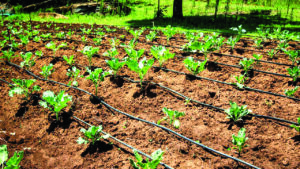Soft, even rainfall over a field of uniform soil type will allow water to penetrate (sink into) the soil to a similar depth at each point in the field. Each plant has an equal chance of getting the water it needs. Irrigation tries to mimic evenly distributed rainfall, but we can never expect a perfect distribution of water across the field.
Plant growth and crop production is largely determined by the effort that the plant must put in to suck up the water it needs. Plants that receive different quantities of water will grow at different rates. Healthy, large plants will produce well, while smaller plants will be overshadowed by more robust neighbours and not produce a good crop. Good irrigation practice is like being an equal opportunity employer who gives each plant in a field the same chance to thrive.
Irrigation systems need to be designed to distribute water across a field and to each plant as evenly as possible. With a sprinkler irrigation system, for example, water is sprayed into the air and falls to the ground in a distribution pattern. It is the task of the system designer to space sprinklers across the field in such a way that water is distributed as evenly as possible.

Picture 1.
Consider a rotary impact sprinkler. Sprinklers are equipped with 1, 2 or even 3 nozzles. Each nozzle (nozzle size, position and water pressure) contributes to the distribution pattern of water delivered by a single sprinkler (Picture 1).

Picture 2.
Sprinklers are then spaced in the field in such a manner that their distribution patterns overlap to produce an even distribution of water across the whole field (Picture 2).
Farmers should understand that changes to the distribution pattern will result from nozzle wear, incorrect operating pressure, leaks in the system, incorrect placement of sprinklers and many other factors. These changes will almost invariably lead to a loss of irrigation efficiency.
Water distribution is important for all types of irrigation.
In micro-irrigation systems, the emitter often supplies only a single plant. The quantity of water that the plant needs can be delivered at any point of the root zone of the plant. The plant will then develop a root system that fetches water from that point where water is normally available (Picture 3).

Picture 3. (Photo by interplast.com)
In this type of system, it is not important to wet the entire soil surface uniformly. It is, however, very important that each emitter should deliver the same quantity of water. Poor emitter application efficiency will seriously impact on crop production.
The even distribution of irrigation water is very important. Uneven distribution will lead to uneven plant growth rates, which will cause a loss of production (Picture 4).

Picture 4. (Photo by guardian.ng)
This series is published with acknowledgement to the ARC Agricultural Engineering for the use of their manuals. Visit www.arc.agric.za for more information.









